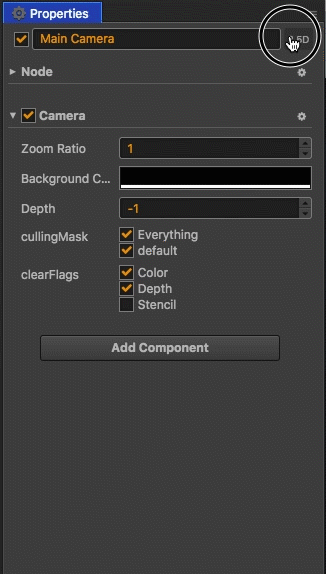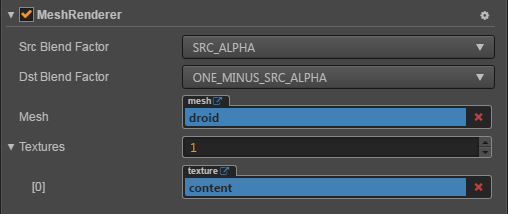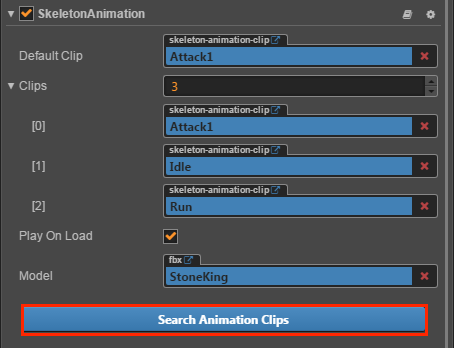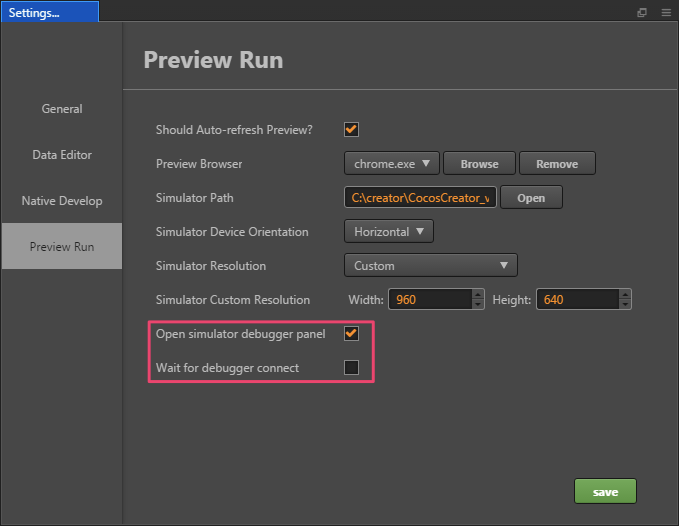Cocos Creator v2.1.0 Release Notes
Cocos Creator v2.1, adds support for 3D features such as: 3D model rendering, 3D Camera, 3D skeletal animation, and 3D point selection. The Cocos Creator editor now natively supports parsing 3D model files of type FBX format. It's that simple, no additional import workflow is required!
In the previous v2.0, Cocos Creator had used a Cocos3D based 3D renderer. With this foundation, 3D support could officially be introduced. The addition of 3D features can greatly enrich the expressiveness of 2D games, reduce the resource overhead of 2D games, and bring more imagination and ideas to expand games.
However, it should be emphasized that the target users of Cocos Creator is still the 2D game development team, and the 2D game is still the core service goal of Cocos Creator 2.x releases. We will continue to optimize the development experience and basic performance of 2D games, and gradually increase the 3D functions suitable for integration into 2D games. Therefore, Cocos Creator will not become a pure 3D engine, which is the goal of Cocos3D. Cocos Creator's roadmap is closer to 2.5D.
This is not the first time Cocos has upgraded the engine from 2D to 3D. A few years ago, Cocos2d-x expanded to the 3D space and accumulated a lot of experience. It also produced a very good game called Art of Conquest. However, at that time, 3D functions were piled up on a very heavy 2D renderer. There was also no editor support. It was not widely recognized by the market. This time, Cocos Creator is based on Cocos3D's 3D renderer, which has a lot of 3D stability and guarantees a seamless editor experience.
Follow-up Version Notice
v2.0 will continue to be maintained, native platform performance will be optimized as soon as possible
v2.0 and v2.1 will grow together over a period of time.v2.0 will continue to be maintained, adding more performance optimizations and bug fixes. We will soon be beta testing v2.0.7. In v2.0.7 the rendering performance of the engine has been optimized, especially Spine and DragonBones. Also, the performance has been greatly improved.
v2.1 iterations will be more aggressive
Compared with v2.0, the upgrade cycle of v2.1 will mainly focus on 3D features. We recommend upgrading new projects with 3D requirements to this version, and establishing contact with us on our forums. This allows us and our 3D partners to provide support. Since v2.1 is a very new version, we will speed up the iteration and try to meet the needs of developers. In particular, currently v2.1.0 version still does not support 3D scene editing, only the 3D parameters can be set in Properties. We will be releasing v2.1.1 in the near future which will support 3D scene editing, material systems and optimizing the 3D development process.
Complete list of changes (compared to v2.0.5)
What's New
3D Node
In v2.1, newly created Nodes are still 2D by default. When needed, you only need to click the 2.5D button at the top right of the Node to switch to 3D mode. After switching, you can edit the z axis. See 3D Node.
You can watch converting to 3D Nodes in action:
 .
.
3D Camera
Like Node, Camera is also divided into two modes. When you add a Camera component to a normal 2D node, it becomes a 2D Camera. When you switch Node to 3D mode, Camera will also enter 3D mode, and then you can edit Camera's FOV and other parameters in 3D mode.
You can watch switching to 3D Camera in action:
 .
.
3D Model Import
Currently, Cocos Creator supports importing the .fbx format of 3D models. .fbx is the de-facto standard in 3D modeling software. The process of importing is very simple, just drag the .fbx model resources into the Assets and wait a few moments for the import to complete. After the import is completed, you can see that the imported model is a folder that can be expanded in Assets. When importing the model, the editor will automatically parse the content of the model and generates resources such as Prefab Meshes and Skeletal Animations and so on. See Import Models

Mesh Renderer Component
Mesh Renderer is used to draw grid resources. See Mesh Renderer.

Skeletal Animation Component
The Skeletal Animation component inherits from the Animation component. Using the Skeletal Animation component is not much different from how you would use the Animation component. The exception is the Skeletal Animation component uses a clip that can only be a Skeletal Animation clip. The Skeletal Animation component is automatically added to the model's Prefab when it is imported. See Skeletal Animation Component for details.

For more 3D instructions, please consult the documentation 3D System.
Optimize Auto Atlas Build Speed
v2.1 greatly optimizes the speed of Auto Atlas construction. If the atlas has not changed, the results of the last build are used.
Further Improve Rendering Performance
Between v2.0 compared to v1.x, there are some cases where the engine does not render batches, resulting in an increase in Draw Calls. v2.1 re-optimized these conditions. For example: the previous color or opacity cannot be batch processed, sliced and non-sliced share the same texture and cannot be batched. The problem that the opacity 0 node still occupies the Draw Call is solved.
Add Simulator Debugging Function
In the Settings -> Preview Run panel, the Open simulator debugger panel option and the Wait for debugger connect option have been added. The purpose of the Open simulator debugger panel option is to automatically open the debug window when the simulator previews the project. The Wait for debugger connect option is used to suspend the boot process until the debugger connection is complete for debugging the load process.

Texture Auto Compression
The compression required by the texture can be set directly in the editor, and Cocos Creator will automatically compress the texture when the project is published. Exporting multiple image formats simultaneously on the web is supported. The engine will automatically download the appropriate format according to the different browsers. See Compressed Textures for details.
Enhancements
Editor
- Dashboard is closed when the project is opened, and automatically opened when the project is closed.
- Dashboard will automatically record the last created project path.
- Optimize the preview of the Button under the editor.
- Optimize the way Button Click Event indexes components, avoiding the loss of indexes after scripts are renamed.
- The new plug-in mall automatically prompts the user to install after the plug-in download is completed.
- When building a WeChat mini-game main context project, the open data context will not be emptied again.
- Modify the API Level selected by default when building the Android platform to the current highest level (Target API Level).
- The node path bar in the scene editor is removed, and the node path can be obtained through the node right-click menu of the hierarchy manager.
- The animation editor defaults to Constant curves for values of type cc.Enum and cc.Integer, without interpolation.
- Animation editor key frame addition and deletion experience optimization.
- The optimization engine automatically compiles the experience.
- Added a series of other experience optimizations.
Engine
- [UI] Added the affectedByScale property to the Layout component. If the developer wants the scaling of the Layout subnode to affect the layout, you can turn it on manually.
- [UI] supports fnt files in XML format.
- [UI] The Content Size of the node will be refreshed immediately when the Label node is onEnable.
- [UI] When the target of Button is not defined, the current node will be used by default.
- [UI] ToggleContainer adds a checkEvents event property similar to Toggle, which fires only when Toggle's isChecked state becomes true.
- [Action] Added support for four actions of
cc.Rotate3DTo, cc.rotate3DTo, cc.Rotate3DBy, cc.rotate3DBy. - [Native] Rejoined WebView and VideoPlayer support removed in v2.0.0 on iOS and Android platforms.
- [Native] The Mac native platform switches to the V8 engine. If you need to use JSC, you need to manually modify the macro. For details, see #1515.
- [Native] Add the missing key and length properties of the native platform LocalStorage, see #1371.
- [Native] Adopts Pinyin input behavior unified with Android on iOS native platform, does not retain input of unfinished pinyin.
- [Android] Upgrade Android compilation to NDK r16+ Clang, and compile Android pre-compiled library with Clang.
- [Android] Upgrade the Android build tool to configure Gradle to 4.4, plugin to 3.1.4. (Gradle 4.6 has a known issue that will cause resource packaging to fail).
- [Android] Optimize Android input box experience.
- [Android] Squeeze Android empty package body, the minimum package body is reduced from 7.0MB to 6.3MB.
- [Web] Increase transparency support for WebView on the web platform.
- [Web] Optimized display position of WebView components.
- [Web] Optimizing the performance of VideoPlayer on the X5 browser.
- [Wechat] Supports getting the res and referrerInfo parameters passed to the platform when responding to the cc.game.EVENT_SHOW event on WeChat Mini Games.
- [VideoPlayer] Optimized the performance of VideoPlayer full-screen playback.
Bug Fixes
Editor
- Fix an issue where the animation editor node list may not be updated.
- Fix the problem of selecting the RichText subnode in the scene editor.
- Fixed an issue where the error code always returned 0 when building a project using the command line, whether or not an error occurred.
- Fixing the background of the mesh in the scene editor will penetrate above some translucent images, causing some differences in color and runtime.
- The editor will report an error when repairing an external drag resource to an invalid location in the resource manager.
- Fixed remote server ip getting error when publishing Android Instant platform.
Engine
- [Core] Problem with activeInHierarchy being true after fixing node destroy.
- [Core] Fix filter in RenderTexture, premultiply alpha setting is invalid.
- [Core] Fixed an issue where the scene introduced by the plugin could not be loaded.
- [Web] Fixed a problem with white afterimages on Chrome 69, 70. (Since 2.0)#3357.
- [UI] Fix Button may have some state invalidation when multiple states are superimposed on each other.
- [UI] Fix LabelOutline setting invalid color problem.
- [UI] Fixed an issue where setting Toggle.isChecked to be invalid in the start method.
- [UI] Fix the problem that the LabelOutline component is not synchronized when the state is modified.
- [Animation] Fixed an issue where the parameters of AnimationState might be parsed as a string type.
- [Native] Fix native platform connection socket.io server may report Bad Request error.
- [Native] Fix iOS and Android can't detect gravity sensor.
- [Native] Fix iOS call cc.game.restart Restart the game and then enter text will crash.
- [Native] Fixing the problem that the opacity attribute of Label on Windows native platform does not work.
- [Native] Fixed an issue where Android could not listen to onKeyUp.
- [Native] Fix the problem that the Android phone will fail to load if the built-in SSL certificate expires.
- [Native] Fixed an issue where server redirection was not supported when downloading images from Android native platform #PR.
- [Physics] Fixed an issue where
MouseJointfailed to respond to touch cancel. - [Spine] Fixes the problem that textures may be lost when Spine is reloaded under Mask.
MIGRATION GUIDE
v2.1 Upgrade Considerations
- Node's
rotationrelated API has been marked as deprecated, and the runtime will prompt to upgrade toangle. See 3D Node - Node API Upgrade. - The NDK version of Android needs to be upgraded to
r16or the compilation will fail.
WeChat Open Data Context
Starting with v2.0.1, Cocos Creator upgraded the open data context solution, see Wechat Open Data Context.
v2.0 Upgrade Guide
See the v2.0 Upgrade Guide.
Resource Upgrade
Since v1.10, Cocos Creator has refactored the underlying resource types. Most projects are not affected, but some projects may receive some warnings. For details, please refer to v1.10 Resource Upgrade Guide.
The above is the update description for v2.1.0. After downloading, create a new example project and open the case under assets/cases/3d to experience it.